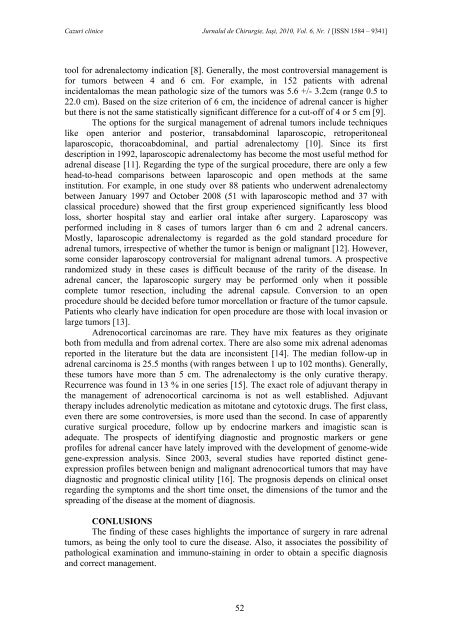Full text PDF (5 MB) - Jurnalul de Chirurgie
Full text PDF (5 MB) - Jurnalul de Chirurgie
Full text PDF (5 MB) - Jurnalul de Chirurgie
Create successful ePaper yourself
Turn your PDF publications into a flip-book with our unique Google optimized e-Paper software.
Cazuri clinice <strong>Jurnalul</strong> <strong>de</strong> <strong>Chirurgie</strong>, Iaşi, 2010, Vol. 6, Nr. 1 [ISSN 1584 – 9341]<br />
tool for adrenalectomy indication [8]. Generally, the most controversial management is<br />
for tumors between 4 and 6 cm. For example, in 152 patients with adrenal<br />
inci<strong>de</strong>ntalomas the mean pathologic size of the tumors was 5.6 +/- 3.2cm (range 0.5 to<br />
22.0 cm). Based on the size criterion of 6 cm, the inci<strong>de</strong>nce of adrenal cancer is higher<br />
but there is not the same statistically significant difference for a cut-off of 4 or 5 cm [9].<br />
The options for the surgical management of adrenal tumors inclu<strong>de</strong> techniques<br />
like open anterior and posterior, transabdominal laparoscopic, retroperitoneal<br />
laparoscopic, thoracoabdominal, and partial adrenalectomy [10]. Since its first<br />
<strong>de</strong>scription in 1992, laparoscopic adrenalectomy has become the most useful method for<br />
adrenal disease [11]. Regarding the type of the surgical procedure, there are only a few<br />
head-to-head comparisons between laparoscopic and open methods at the same<br />
institution. For example, in one study over 88 patients who un<strong>de</strong>rwent adrenalectomy<br />
between January 1997 and October 2008 (51 with laparoscopic method and 37 with<br />
classical procedure) showed that the first group experienced significantly less blood<br />
loss, shorter hospital stay and earlier oral intake after surgery. Laparoscopy was<br />
performed including in 8 cases of tumors larger than 6 cm and 2 adrenal cancers.<br />
Mostly, laparoscopic adrenalectomy is regar<strong>de</strong>d as the gold standard procedure for<br />
adrenal tumors, irrespective of whether the tumor is benign or malignant [12]. However,<br />
some consi<strong>de</strong>r laparoscopy controversial for malignant adrenal tumors. A prospective<br />
randomized study in these cases is difficult because of the rarity of the disease. In<br />
adrenal cancer, the laparoscopic surgery may be performed only when it possible<br />
complete tumor resection, including the adrenal capsule. Conversion to an open<br />
procedure should be <strong>de</strong>ci<strong>de</strong>d before tumor morcellation or fracture of the tumor capsule.<br />
Patients who clearly have indication for open procedure are those with local invasion or<br />
large tumors [13].<br />
Adrenocortical carcinomas are rare. They have mix features as they originate<br />
both from medulla and from adrenal cortex. There are also some mix adrenal a<strong>de</strong>nomas<br />
reported in the literature but the data are inconsistent [14]. The median follow-up in<br />
adrenal carcinoma is 25.5 months (with ranges between 1 up to 102 months). Generally,<br />
these tumors have more than 5 cm. The adrenalectomy is the only curative therapy.<br />
Recurrence was found in 13 % in one series [15]. The exact role of adjuvant therapy in<br />
the management of adrenocortical carcinoma is not as well established. Adjuvant<br />
therapy inclu<strong>de</strong>s adrenolytic medication as mitotane and cytotoxic drugs. The first class,<br />
even there are some controversies, is more used than the second. In case of apparently<br />
curative surgical procedure, follow up by endocrine markers and imagistic scan is<br />
a<strong>de</strong>quate. The prospects of i<strong>de</strong>ntifying diagnostic and prognostic markers or gene<br />
profiles for adrenal cancer have lately improved with the <strong>de</strong>velopment of genome-wi<strong>de</strong><br />
gene-expression analysis. Since 2003, several studies have reported distinct geneexpression<br />
profiles between benign and malignant adrenocortical tumors that may have<br />
diagnostic and prognostic clinical utility [16]. The prognosis <strong>de</strong>pends on clinical onset<br />
regarding the symptoms and the short time onset, the dimensions of the tumor and the<br />
spreading of the disease at the moment of diagnosis.<br />
CONLUSIONS<br />
The finding of these cases highlights the importance of surgery in rare adrenal<br />
tumors, as being the only tool to cure the disease. Also, it associates the possibility of<br />
pathological examination and immuno-staining in or<strong>de</strong>r to obtain a specific diagnosis<br />
and correct management.<br />
52

















